Japanese residence / 日本(にほん)の住居(じゅうきょ)
We will introduce the manners in a Japanese house and points to be aware of when visiting.
日本の家でのマナーや訪問時に気をつけた方が良い点などをご紹介します。
Types of housing / 住宅の種類
Types of housing include detached houses, condominiums, apartments, terrace houses, and maisonettes (a collective housing where each dwelling unit is a two-story type).
住宅の種類には、一戸建て、マンション、アパート、テラハウス、メゾネットなどがあります。
House / 一戸建て

Condominium / マンション
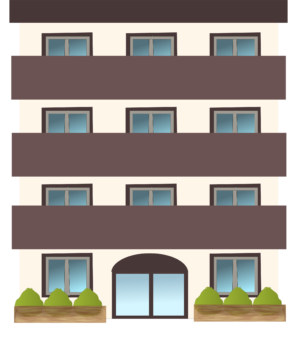
Apartment / アパート

Terrace houses / テラハウス
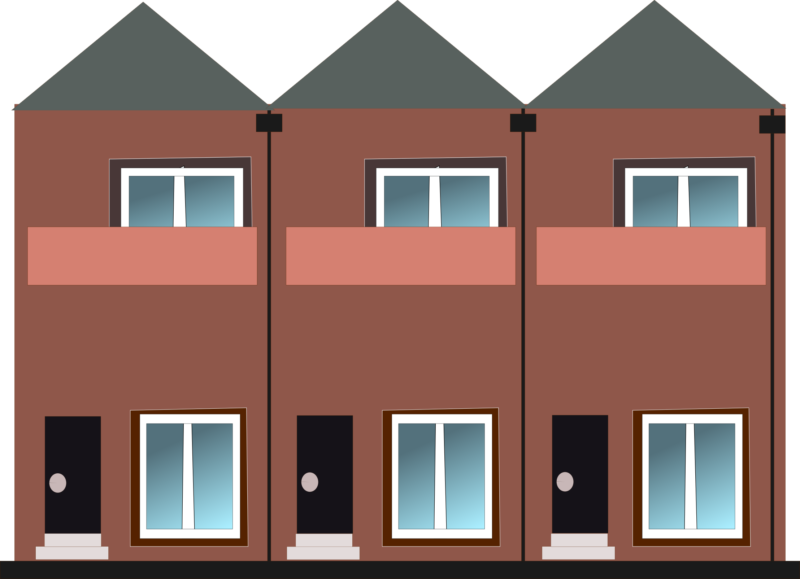
Maisonettes / メゾネット

A house layout of a typical Japanese residence / 一般的な日本の住居の見取図

- The entrance hall (a small space to take off your shoes and enter the house)
- Stairs
- Corridor / Hallway
- Closet
- Toilet / Bathroom / Washroom / Restroom
- Bathroom / Washroom / A place where to take a bath or shower
- Japanese room / Tatami room
- Living room
- Dining room
- Kitchen
- Earth floor / Dirt floor
- Verandah / Balcony
- Western-style room
- Garden
- Gate
- 玄関(genkan)
- 階段(kaidan)
- 廊下(rouka)
- 押入(oshiire)
- トイレ(toire)
- 浴室(yokushitsu)+洗面所(senmenjo)
- 和室(washitu)
- 居間(ima)
- 食堂(shokudo)
- 台所(daidokoro)
- 土間(doma)
- ベランダ(beranda)/ バルコニー(barukonii)
- 洋室(yoshitsu)
- 庭(niwa)
- 門(mon)
(1) The entrance hall / 玄関(げんかん)
Japanese houses have a small space where you have to take off your shoes before entering the house. It is located just inside the entrance, and is called “genkan” in Japanese.
In many Japanese homes, you take off your shoes at the entrance before entering. ①With your back to the front door, take off your shoes, go up to the house, turn your body diagonally, ②get on your knees, and align the toes of the removed shoes toward the front door.
Coats are taken off in front of the entrance door.
日本の家屋には、靴を脱いで家の中に入るための小さなスペースがあります。それは、入り口を開けてすぐのところにあり、玄関と呼びます。
多くの日本の家では、玄関で靴を脱いで家の中に入ります。①玄関を背にしたまま靴を脱いで、一旦、家に上がってから体の向きを斜めに変えて、②膝をついて、脱いだ靴のつま先を玄関のドアに向けて揃えます。
コートは、玄関のドアの前で脱ぎます。
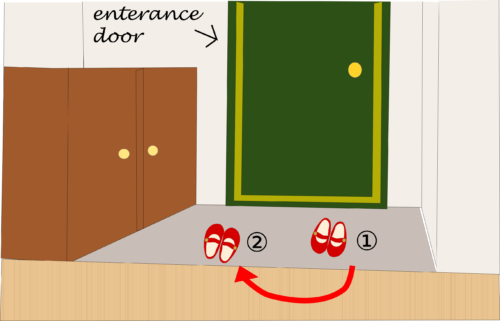
(2) Japanese room / 和室(わしつ)
To enter a Japanese-style room (tatami room), take off your slippers. In a Japanese-style room, it is considered good manners not to step on the following three things.
- the threshold
- the edge of tatami
- the Japanese cushion (zabuton)
Be careful not to sit on the edge of tatami.
和室(畳の部屋)へは、スリッパを脱いで入ります。和室では、下記の三つを踏まないのがマナーとされています。
- 敷居(しきい)
- 畳(tatami)の縁(fuchi)
- 座布団(zabuton)
畳の縁に座らないように気をつけましょう。
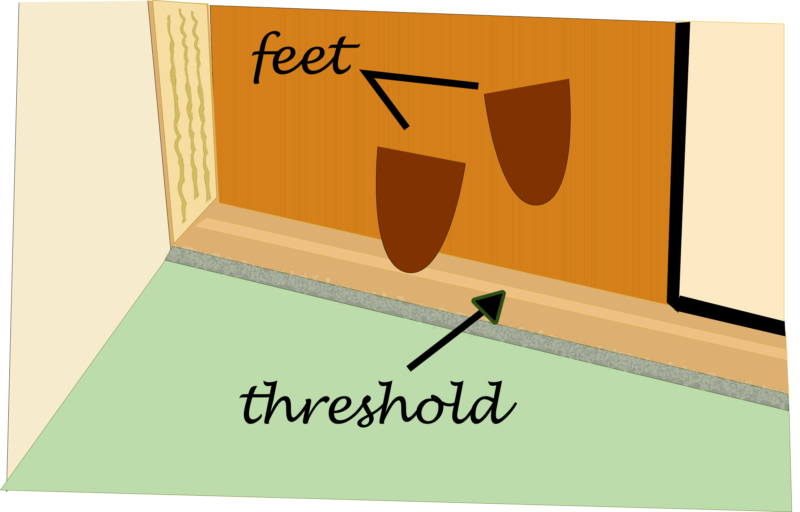
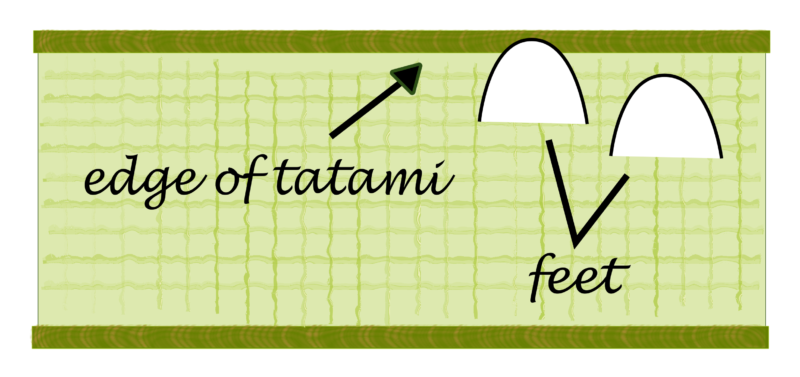
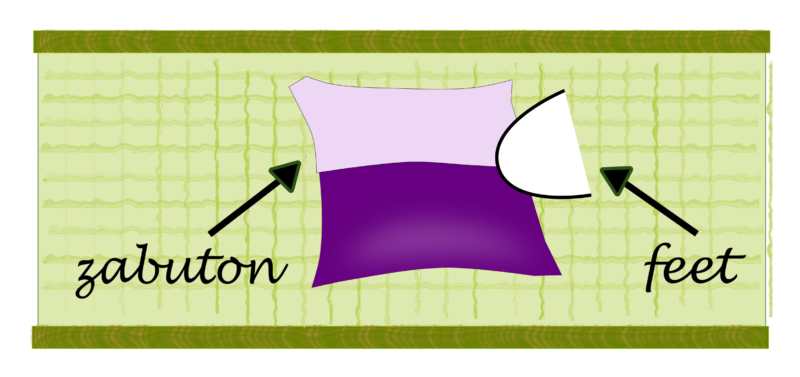
In Japanese rooms, regardless of whether they are Western-style or Japanese-style, many doors are opened and closed by sliding sideways.
In particular, shoji and fusuma are often used as sliding doors in Japanese-style rooms.
A fusuma is a door with paper or cloth pasted on both sides of a frame made of wood, etc., and has edges and handles. It has been used as a partition in Japanese-style rooms for a long time. Fusuma with pictures can also be used as interior decoration.
A shoji is a door made of washi paper pasted on a lattice-shaped wooden frame. It is used on the porch, etc., because it is well-lighted.
When opening the fusuma and entering a Japanese-style room at the place you visit, the basic etiquette is to say “Excuse me” to the person inside, then sit down and open it quietly.
日本の部屋では、洋室・和室問わず、横にスライドさせて開け閉めする戸が多く使われています。
特に、和室ではスライド式のドアとして、障子や襖が多く使われています。
襖は、木などでできた骨格の両面に紙や布を貼り、縁や引手をつけた扉で、古くから和室で間仕切りとして使用されています。絵が描かれた襖は、室内装飾としても用いられます。
障子は、格子状の木枠に和紙でできた障子紙を貼った扉で、採光があるため、縁側などで使用されます。
訪問先で、襖を開けて和室の中に入る時は、中の人に「失礼します」と一声かけてから、座って静かに開けるのが基本的なマナーです。
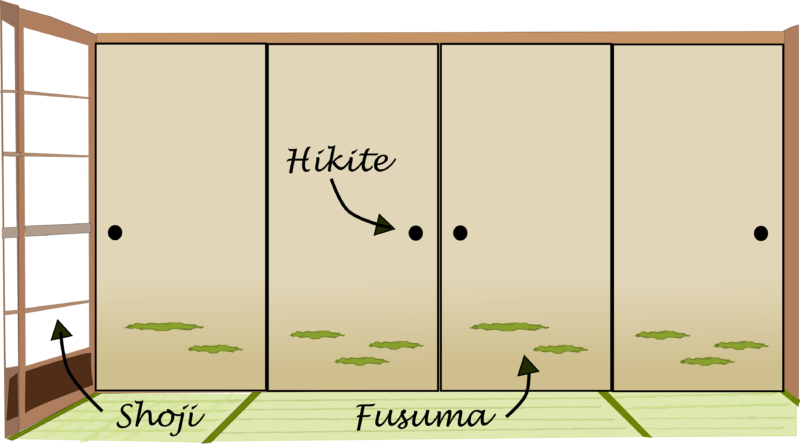
(3) Bathroom : Toilet / トイレ・御手洗
In Japan, the bathroom and toilet are often separated, and the toilet door is generally closed after use. Before entering, it’s a custom to knock lightly to make sure it is not occupied.
Many households have “toilet-use-only” slippers in the toilet. In that case, take off the slippers and exit the toilet after using them.
To put it more politely, the toilet is called “otearai” in Japanese.
日本では、浴室とトイレが別れていることが多く、トイレのドアは、使用後は閉めるのが一般的です。入る前に、軽くノックして空いているか確認すると良いでしょう。
トイレには、専用のスリッパを置いている家庭も多くあります。その場合、使用後はトイレ用スリッパを脱いでトイレから出ます。
トイレを丁寧に言うと、御手洗です。
(4) Bathroom : Bathtub, shower / 浴室(よくしつ):浴槽(よくそう)、シャワー
In Japan, many bathrooms are equipped with a bathtub, washing area, and shower. To take a bath, wash your body outside the bathtub, wash off the soap from your body with hot water, and then soak in the hot water.
When using a bath with your family, leave the water in the bathtub and drain the bathtub after everyone in the family has finished bathing. The bath lid prevents steam from spreading and the water from cooling down.
日本では、浴槽・洗い場・シャワーを備えている浴室が多くあります。お風呂の入り方は、浴槽の外で身体を洗い、お湯で身体の石鹸を流してから浴槽のお湯につかります。
家族でお風呂を使う時は、お湯は溜めたままで、家族全員が入り終えたら、浴槽からお湯を流します。風呂フタで、湯気の広がりやお湯が冷めるのを防ぎます。

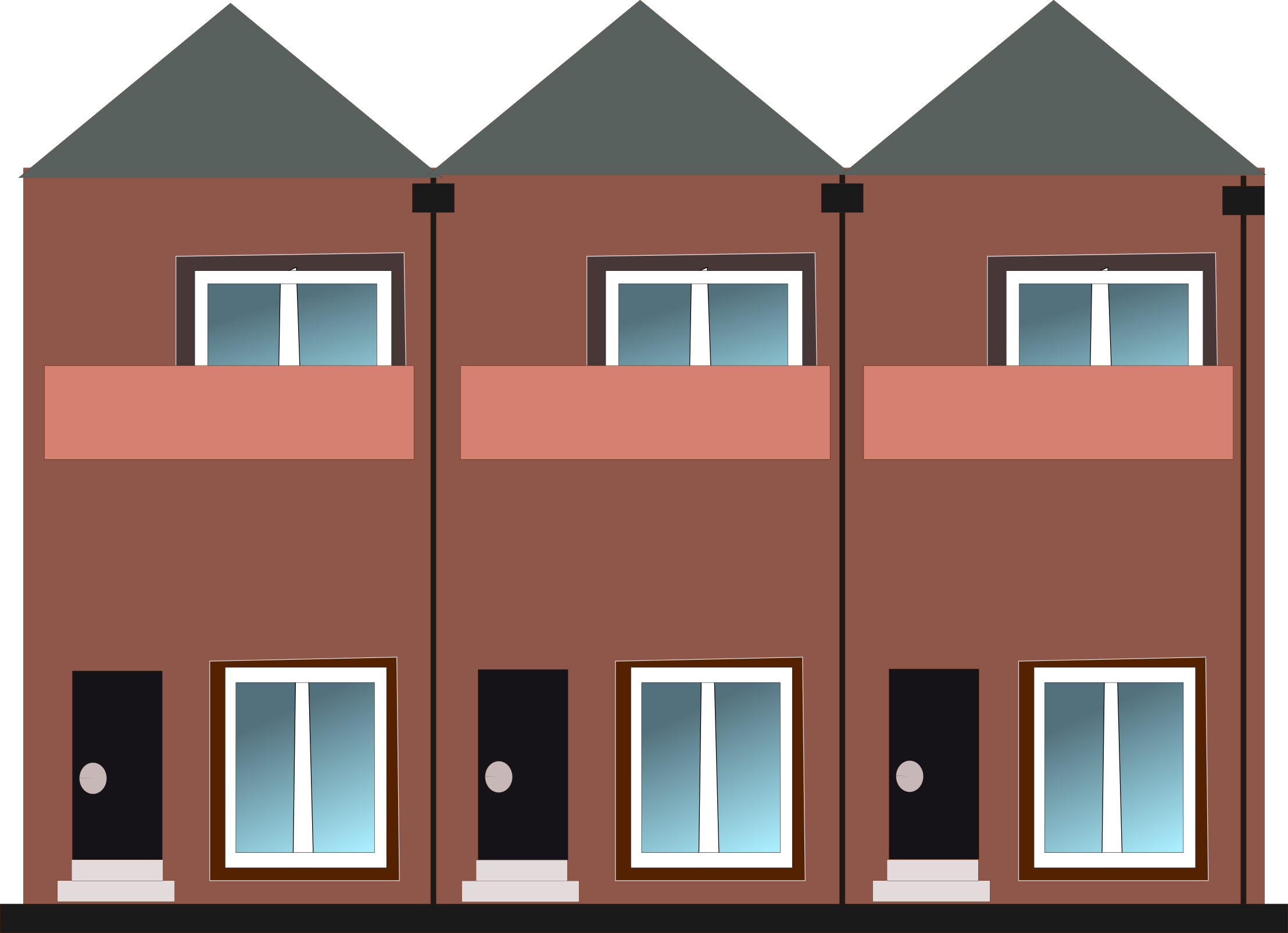


Comments